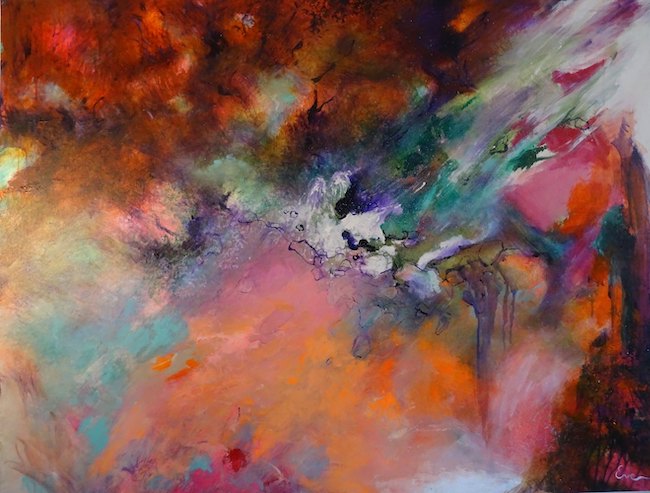Nell’espressione creativa contemporanea l’artista tende spesso a infondere nelle sue opere il proprio punto di vista, il messaggio che fuoriesce a seguito di riflessioni od osservazioni più razionali e che si manifesta attraverso forme indefinite, oppure tramite la riproduzione perfetta della realtà, o ancora con la rappresentazione personale su quanto ruota intorno, ma comunque sempre in maniera soggettiva, come se il risultato finale non potesse essere scollegato dal mondo interiore dell’autore della tela. L’artista di cui vi parlerò oggi invece sembra compiere un percorso contrario, sembra essere la mano esecutrice e interpretante di emozioni che riceve dall’esterno, come se tutto ciò che entra nella sua sfera di osservazione avesse una propria voce, un proprio sentire che necessita di essere ascoltato.
La magia dell’associazione tra arte e mondo interiore ha iniziato a divenire via via più importante tra la fine dell’Ottocento e gli inizi del Novecento, quando cioè il coraggio degli artisti aderenti all’Espressionismo divenne traino per tutta quella categoria di creativi che non riuscivano più a sottostare alle regole accademiche tutte concentrate sull’estetica e la perfezione delle forme che però tralasciava quell’ampia sfera conoscitiva e interpretativa che poteva vedere la luce solo seguendo un percorso diverso, contrario a volte, ma in grado di dare un senso nuovo al rapporto con la tela. Quegli anni furono tuttavia dinamici dal punto di vista espressivo così a fianco della rinuncia alla tendenza di riproduzione fedele della realtà ma con ancora un forte legame alla figurazione tipica dell’Espressionismo di Franz Marc, Paul Gauguin, Erich Heckel, Vincent Van Gogh, Emil Nolde solo per citarne alcuni, nacquero anche alcuni movimenti che all’elemento figurativo intendevano rinunciare per elevarsi a una maggiore autonomia plastica e per affermare la capacità dell’arte di avere una vita propria anche se staccata da tutto ciò che l’occhio umano conosceva. Fu in quel contesto che si delineò la produzione artistica di quello che a tutt’oggi è ancora considerato il padre dell’Astrattismo, Vassily Kandinsky, il quale si spostò verso un’eliminazione di tutto il conoscibile attraverso l’esperienza per tendere verso l’irrazionale che perse però l’irruenza e la forza comunicativa dell’Espressionismo per entrare in un mondo più equilibrato, silenzioso ma ugualmente in ascolto delle energie sottili che avvolgevano l’essere umano e con cui era più facile entrare in connessione attraverso la musica, elemento essenziale del suo dipingere. Malgrado un lungo periodo in cui l’evoluzione dell’Astrattismo si staccò dall’intento iniziale di Kandinsky e si spostò gradualmente verso il totale rifiuto dell’emozione, come per il Neoplasticismo, il Suprematismo e l’Astrattismo Geometrico, vi fu però negli anni Cinquanta un ritorno alla consapevolezza che l’arte non potesse restare a lungo distante da un sentire interiore che di fatto ne costituisce l’essenza stessa; dunque da un lato l’assenza di attinenza alla realtà costituiva una base perfetta per distaccarsi dalla razionalità che inevitabilmente apparteneva a un approccio più studiato e tecnico come il Realismo, dall’altro però non era più possibile arginare l’istinto, l’impulso espressivo e il contatto con l’interiorità che era l’unica in grado di giungere diretta all’osservatore coinvolgendolo. Fu questa la linea guida dell’Espressionismo Astratto, nato negli Stati Uniti per mano di Jackson Pollock, Ad Reinhardt, e Mark Rothko, unita alla libertà di ciascun componente del gruppo di scegliere il linguaggio più affine alle proprie caratteristiche e inclinazioni naturali; dal più irruento e impetuoso a quello meditato e sereno, tutto era accolto all’interno del movimento purché le emozioni fossero protagoniste.
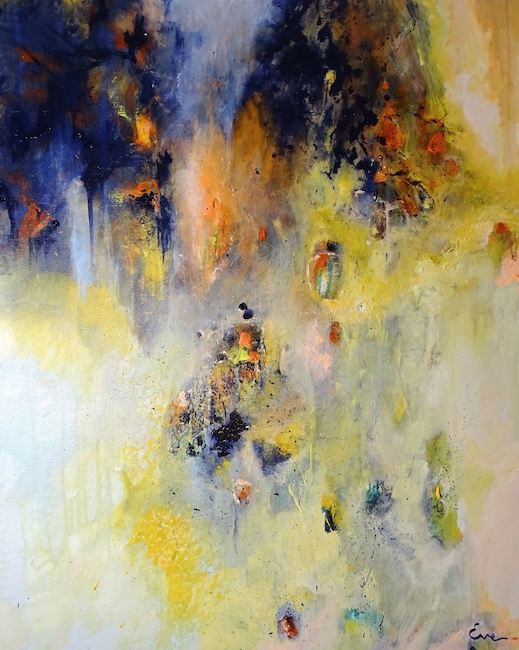
L’artista francese Eve Fouquet fa sua la linea guida dell’Espressionismo Astratto mostrando però un’attitudine differente poiché nelle sue tele più che tendere con la propria interiorità verso l’esterno sembra porsi in posizione di ascolto, di ricezione di tutte le emozioni che nell’atmosfera circostante al suo punto di osservazione si muovono, trasformandosi così in interprete esecutiva del sentire nascosto delle cose, animate e inanimate, da cui la sua straordinaria apertura empatica non può distaccarsi. La gamma cromatica è sempre intensa, pieni sono i toni che però vengono sfumati e accostati tra loro per contribuire a infondere un volume lirico più alto, proprio perché normalmente tutto ciò che è estraneo all’individuo viene ignorato, nel caso della Fouquet si amplifica e si evidenzia mostrando tutte le sue tinte forti, chiare, necessarie per rompere il silenzio dentro cui abitualmente vengono nascoste.
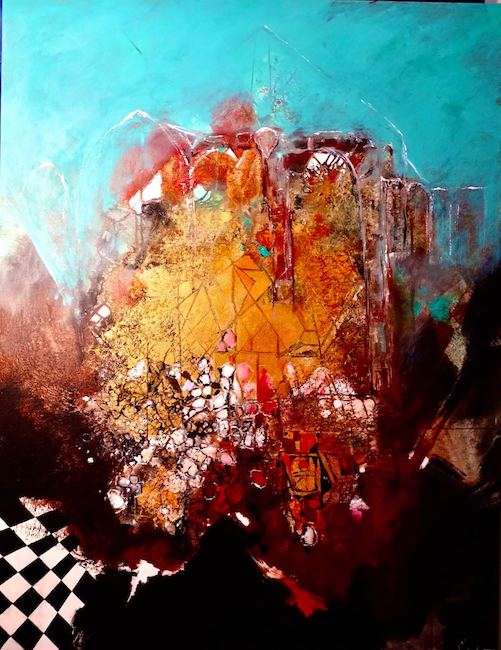
Non esiste emozione senza la capacità di mettersi in contatto con tutto ciò che ci circonda, suggerisce l’artista, non si può prescindere dall’ambiente, dal vissuto e dall’assorbito nella quotidianità pur ammettendo la necessità di distaccarsi dal lato più razionale, ed è per questo che rinuncia alla forma esteriore, per immergersi in maniera totale all’interno delle sensazioni che hanno un percorso inverso a quello abitualmente seguito, e che fanno vibrare con la loro musicalità le corde di Eve Fouquet che traduce quel sentire in rappresentazione cromatica.
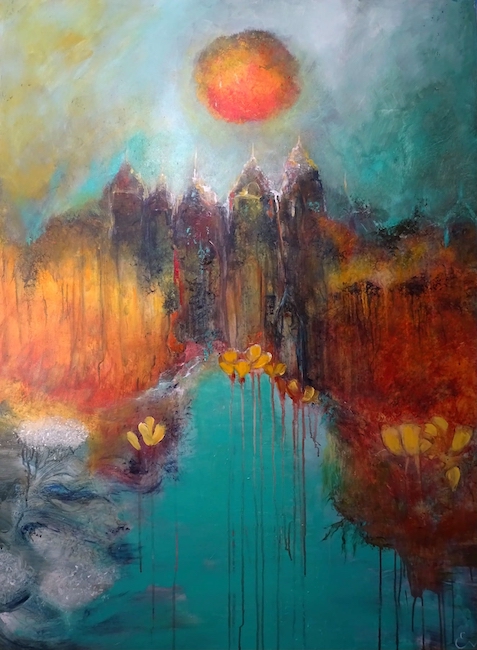
La tela L’intime des lisières (L’intimo dei bordi) mostra tutta la poesia che trapela da un’osservazione rapita, completamente coinvolta nell’osservato, come se l’atto del guardare non potesse essere scisso dal percepire tutto ciò che all’interno del paesaggio si muove; i bordi del titolo possono essere riferiti ai lati della linea centrale dell’opera, dunque intesi come frammenti secondari ma non meno importanti proprio per il loro costituire un limite reale al cammino, ma al tempo stesso potrebbero riferirsi ai limiti che l’essere umano si pone ogni qualvolta intraprende una strada nuova, spesso frenato dai timori, dalle incertezze che costituiscono pertanto un rallentamento verso il raggiungimento della meta, idealmente rappresentata dall’orizzonte.
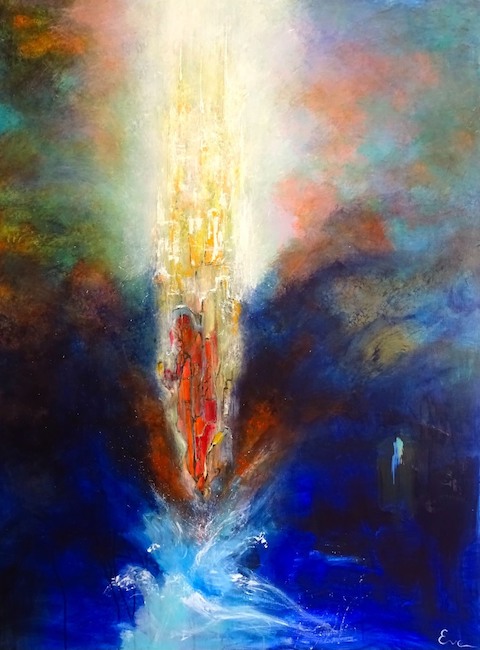
In La cittadelle du coeur (La cittadina del cuore) Eve Fouquet pone al centro una colonna di emozioni, un fascio fumoso che sembra partire dal basso con tonalità più scure a descrivere le profondità dell’animo, quel mondo ricco e denso in cui spesso le emozioni si muovono in modo inconsapevole, inconscio quasi, per poi schiarirsi vero l’alto fino a divenire luce, una consapevolezza del sentire raggiungibile solo dopo aver fatto i conti con il buio iniziale. La tendenza alla risalita simboleggia la necessità evolutiva dell’essere umano, quell’aspirare a un miglioramento, un’elevazione che può essere conquistata solo nel momento in cui si comprende che è l’interiorità a divenire guida di tutto ciò che può essere raggiunto anche all’esterno.
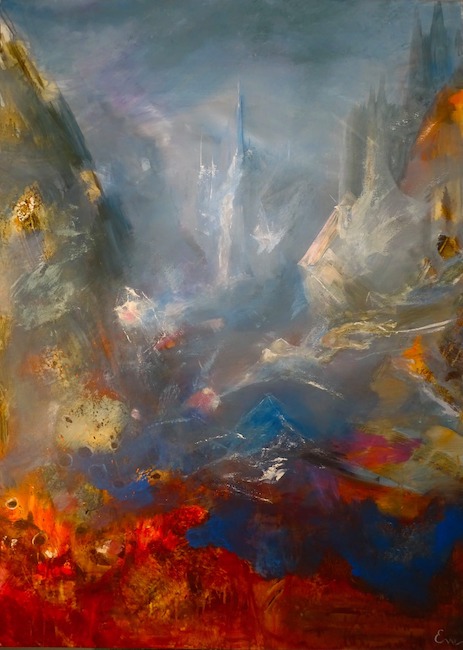
E ancora in Le chant des grandes Solitudes (Il canto delle grandi solitudini) l’artista dà poeticamente voce a quel sentimento di nostalgia, quella saudade brasiliana che emerge quando il protagonista del sentire resta solo con se stesso, ascolta il vuoto interiore che contraddistingue proprio il percorso individuale durante il quale prende atto del proprio stato, raccoglie i ricordi, il bagaglio di emozioni che hanno contraddistinto il percorso precedente e che, nel momento della presa d’atto del distacco, della fine o semplicemente della fase solitaria, fanno sentire la loro eco. È proprio questa la sensazione che si riceve guardando la tela, quella di un’eco che aleggia nell’atmosfera lasciandosi andare al flusso circostante che culla quello interiore il quale non può essere arginato, né tanto meno ignorato; i rossi della precedente emozione della parte bassa dell’opera si propagano verso il grigio che rappresenta l’assenza del presente, quel mondo solitario a cui l’essere umano si abitua ma che in fondo non lo rende felice.
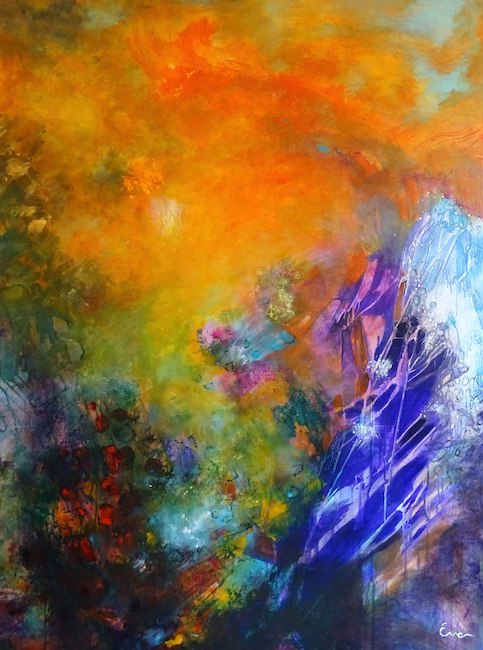
L’accostamento delle tonalità nella produzione artistica di Eve Fouquet è più forte di qualsiasi elemento conosciuto dallo sguardo, sembrano strutturare il senso delle opere in maniera incisiva, decisa, coinvolgente senza però risultare mai invasive, aggressive tutt’altro, si percepisce una morbidezza, una delicatezza interpretativa che deriva proprio dall’empatia che appartiene all’indole personale e artistica di Eve Fouquet.

Ciò a cui punta con la sua produzione artistica è scorgere quell’invisibile che ruota intorno all’essere umano spesso troppo distratto o preso da se stesso per ascoltare la forza energetica che potrebbe ricavare da un atteggiamento meno superficiale, fermo all’apparenza piuttosto che andare verso la sostanza. Arteterapeuta e insegnante d’arte, Eve Fouquet ha al suo attivo la partecipazione a diverse mostre in Francia e all’estero ma opera nel suo laboratorio à Lodève, cittadina non lontana da Montpellier.
EVE FOUQUET-CONTATTI
Email: evefouquet@yahoo.fr
Sito web: www.evefouquet.com
Facebook: https://www.facebook.com/eve.fouquet
Instagram: https://www.instagram.com/eve.fouquet/
The intense language of emotions in the lyrical poetry of Eve Fouquet’s Abstract Expressionism
In contemporary creative expression, the artist often tends to infuse his own point of view into his artworks, the message that emerges as a result of more rational reflections or observations and that manifests itself through indefinite forms, or through the perfect reproduction of reality, or even through personal representation of what revolves around, but always in a subjective manner, as if the final result could not be disconnected from the inner world of the author of the canvas. The artist I am going to talk about today, on the other hand, seems to take an opposite path, she seems to be the executing and interpreting hand of emotions she receives from the outside, as if everything that enters her sphere of observation had its own voice, its own feeling that needs to be heard.
The magic of the association between art and the inner world started to become more and more important between the end of the 19th century and the beginning of the 20th century, when the courage of the artists adhering to Expressionism became a driving force for that whole category of creative artists who could no longer submit to the academic rules all focused on aesthetics and the perfection of forms, which, however, left out that broad cognitive and interpretative sphere that could only see the light by following a different path, contrary at times, but able to give a new sense to the relationship with the canvas. Those years were nevertheless dynamic from an expressive point of view, so alongside the renunciation of the tendency to faithfully reproduce reality but still with strong ties to the figuration typical of the Expressionism of Franz Marc, Paul Gauguin, Erich Heckel, Vincent Van Gogh and Emil Nolde to name but a few, a number of movements were born that intended to renounce the figurative element in order to elevate themselves to a greater plastic autonomy and to affirm the capacity of art to have a life of its own even if detached from everything the human eye knew. It was in this context that the artistic production of what is still today considered the father of Abstractionism, Vassily Kandinsky, took shape. He moved towards an elimination of all that is knowable through experience in order to tend towards the irrational, but lost the impetuousness and communicative force of Expressionism in order to enter a more balanced world, silent but still listening to the subtle energies that enveloped the human being and with which it was easier to connect through music, an essential element of his painting.
Despite a long period in which the evolution of Abstractionism broke away from Kandinsky’s initial intent and gradually moved towards a total rejection of emotion, as with Neo-Plasticism, Suprematism and Geometric Abstractionism, there was, however, in the 1950s a return to the realisation that art could not remain distant for long from an inner feeling that in fact constituted its very essence; thus, on the one hand, the absence of any connection to reality constituted a perfect basis for detaching oneself from the rationality that inevitably belonged to a more studied and technical approach such as Realism; on the other hand, however, it was no longer possible to curb instinct, the expressive impulse and contact with the interiority that was the only one capable of reaching the observer directly and involving him. This was the guiding principle of Abstract Expressionism, born in the United States at the hands of Jackson Pollock, Ad Reinhardt, and Mark Rothko, combined with the freedom of each member of the group to choose the language most akin to their natural characteristics and inclinations; from the most impetuous and rushing to the more meditated and serene, everything was welcomed within the movement as long as emotions were the protagonists.
The French artist Eve Fouquet adopts the guiding line of Abstract Expressionism, showing, however, a different attitude, since in her canvases, rather than tending outwards with her own interiority, she seems to place herself in a position of listening, of receiving all the emotions that move in the atmosphere surrounding her point of observation, thus transforming herself into an executive interpreter of the hidden feeling of things, animate and inanimate, from which her extraordinary empathic openness cannot detach herself. The chromatic range is always intense, full are the tones that are, however, blurred and juxtaposed to contribute to instilling a higher lyrical volume, precisely because normally everything that is extraneous to the individual is ignored, in Fouquet’s case it is amplified and highlighted by showing all its strong, clear hues, necessary to break the silence within which they are usually hidden. There is no emotion without the ability to get in touch with everything that surrounds us, suggests the artist, one cannot ignore the environment, the lived and absorbed in everyday life while admitting the need to detach oneself from the more rational side, and this is why she renounces the external form, to immerse herself totally within the sensations that have an inverse path to the one usually followed, and that make Eve Fouquet’s chords vibrate with their musicality, translating that feeling into chromatic representation.
The canvas L’intime des lisières (The Intimate of the Edges) shows all the poetry that leaks out from a rapt observation, completely involved in the observed, as if the act of looking could not be separated from perceiving everything that moves within the landscape; the edges of the title may refer to the sides of the central line of the artwork, thus understood as secondary fragments but no less important precisely because they constitute a real limit to the journey, but at the same time they could refer to the limits that the human being sets for himself every time he embarks on a new road, often held back by fears, by uncertainties that therefore constitute a slowdown towards reaching the goal, ideally represented by the horizon. In La cittadelle du coeur (The citadel of the heart) Eve Fouquet places a column of emotions at the centre, a smoky beam that seems to start from the bottom with darker hues to describe the depths of the soul, that rich and dense world in which emotions often move unaware, unconscious almost, only to lighten up until they become light, a consciousness of feeling that can only be reached after coming to terms with the initial darkness. The tendency to ascend symbolises the evolutionary necessity of the human being, that aspire to an improvement, an elevation that can only be conquered when one understands that it is interiority that becomes the guide to everything that can also be achieved externally. And again in Le chant des grandes Solitudes (The Song of the Great Solitudes), the artist poetically gives voice to that sentiment of nostalgia, that Brazilian saudade that emerges when the protagonist of the feeling remains alone with himself, listens to the inner emptiness that characterises the individual journey during which he takes note of his own state, gathers memories, the baggage of emotions that marked the previous path and that, at the moment of the acknowledgement of the detachment, of the end or simply of the solitary phase, make their echoes heard.
This is precisely the sensation one receives when looking at the canvas, that of an echo hovering in the atmosphere, letting itself go to the surrounding flow that cradles the inner one which cannot be contained, let alone ignored; the reds of the previous emotion in the lower part of the artwork propagate towards the grey that represents the absence of the present, that solitary world to which the human being gets used to but which does not make him happy after all. The combination of tones in Eve Fouquet’s artistic production is stronger than any element known to the eye, they seem to structure the sense of the paintings in an incisive, decisive, involving way without ever being invasive, aggressive on the contrary, one perceives a softness, an interpretative delicacy that derives precisely from the empathy that belongs to Eve Fouquet’s personal and artistic nature. What she is aiming at with her artistic production is to glimpse the invisible that revolves around the human being who is often too distracted or self-absorbed to listen to the energetic force that he could derive from a less superficial attitude, firm in appearance rather than going towards substance. An art therapist and art teacher, Eve Fouquet has taken part in several exhibitions in France and abroad, but works in her workshop in Lodève, a town not far from Montpellier.


